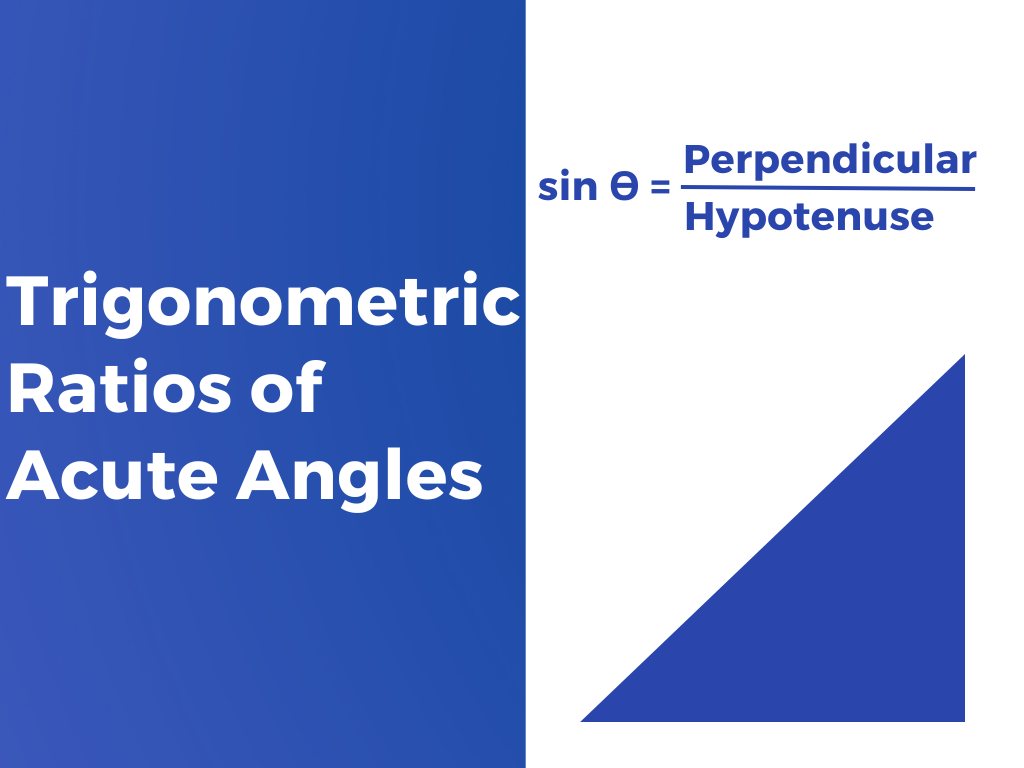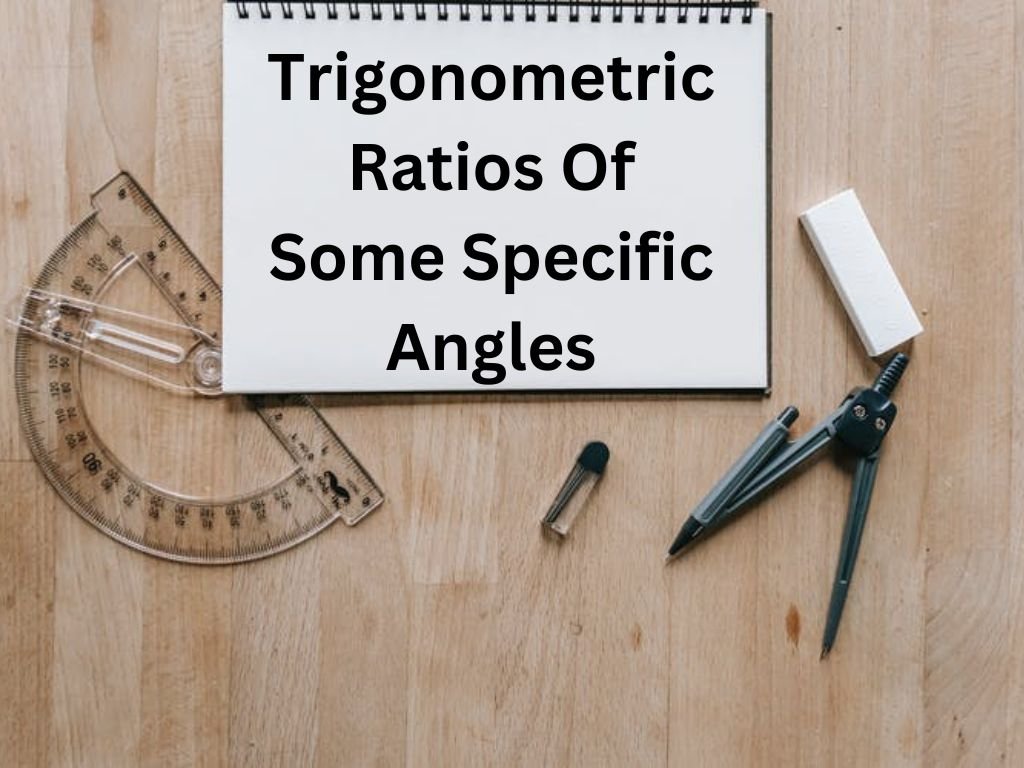Introduction
We know that the reciprocal of sin ϴ, cos ϴ, and tan ϴ is cosec ϴ, sec ϴ, and cot ϴ respectively. Therefore, some formulae are here which show the Relation Between Trigonometric Ratios.
Derivation of Formula and Explanation
If we assume △PQR,

sin ϴ = PQ/PR and cosec ϴ = PR/PQ
sin ϴ⨯cosec ϴ = PQ/PR⨯PR/PQ
sin ϴ⨯cosec ϴ = 1
Similarly,
1) sin ϴ×cosec ϴ = 1 ⇒ sin ϴ = 1/cosec ϴ and cosec ϴ = 1/sin ϴ
2) cos ϴ×sec ϴ = 1 ⇒ cos ϴ = 1/sec ϴ and sec ϴ = 1/cos ϴ
3) tan ϴ×cot ϴ = 1 ⇒ tan ϴ = 1/cot ϴ and cot ϴ = 1/ tan ϴ
4) tan ϴ = sin ϴ/cos ϴ
∵ sin ϴ = PQ/PR and cos ϴ = QR/PR
Now, sin ϴ/cos ϴ = PQ/PR ∕ QR/PR = PQ/PR×PR/QR = PQ/QR = Perpendicular/Base = tan ϴ
Similarly,
5) cot ϴ = cos ϴ/sin ϴ
Trigonometric Identities
(1) sin2 ϴ + cos2 ϴ = 1
∵ sin ϴ = PQ/PR and cos ϴ = QR/PR [from the above figure]
LHS
sin2 ϴ + cos2 ϴ
(PQ/PR)2 + (QR/PR)2
PQ2/PR2 + QR2/PR2
PQ2 + QR2/PR2
PR2/PR2 = 1 = RHS (by Pythagoras theorem PR2 = PQ2 + QR2)
(2) 1 + tan2 ϴ = sec2 ϴ
∵ tan ϴ = PQ/QR [from the above figure]
LHS
1 + tan2 ϴ
1 + (PQ/QR)2
1 + PQ2/QR2
QR2 + PQ2/QR2
PR2/QR2 = (PR/QR)2 = sec2 ϴ = RHS
Alternate Method –
We know that, sin2 ϴ + cos2 ϴ = 1
Divide both sides by cos2 ϴ
sin2 ϴ/cos2 ϴ + cos2 ϴ/cos2 ϴ = 1/cos2 ϴ (∵ tan ϴ = sin ϴ/cos ϴ)
tan2 ϴ + 1 = sec2 ϴ
(3) 1 + cot2 ϴ = cosec2 ϴ
∵ cot ϴ = QR/PQ [from the above figure]
LHS
1 + cot2 ϴ
1 + (QR/PQ)2
1 + QR2/PQ2
PQ2 + QR2/PQ2
PR2/PQ2 = (PR/PQ)2 = cosec2 ϴ = RHS
Alternate Method –
We know that, sin2 ϴ + cos2 ϴ = 1
Divide both sides by sin2 ϴ
sin2 ϴ/sin2 ϴ + cos2 ϴ/sin2 ϴ = 1/sin2 ϴ (∵ cot ϴ = cos ϴ/sin ϴ)
1 + cot2 ϴ = cosec2 ϴ
Note – 1) (sin ϴ)2 = sin2 ϴ ≠ sin ϴ2
It means (sin ϴ)2 can be written as sin2 ϴ but cannot be written as sin ϴ2. The same applies to other trigonometric functions.
2) Trigonometric identities can be written as –
| sin2 ϴ + cos2 ϴ = 1 | 1 + tan2 ϴ = sec2 ϴ | 1 + cot2 ϴ = cosec2 ϴ |
| sin2 ϴ = 1 – cos2 ϴ | sec2 ϴ – tan2 ϴ = 1 | cosec2 ϴ – cot2 ϴ = 1 |
| cos2 ϴ = 1 – sin2 ϴ | tan2 ϴ = sec2 ϴ – 1 | cot2 ϴ = cosec2 ϴ – 1 |
Example – If sin ϴ = 5/13 then find all the trigonometric functions using the relation between trigonometric ratios, where ϴ is an acute angle.
Solution – Here, sin ϴ = 5/13
We know that sin2 ϴ + cos2 ϴ = 1
(5/13)2 + cos2 ϴ = 1
cos2 ϴ = 1 – (25/169)
cos ϴ = √(169-25)/169 = √(144/169) = 12/13
∵ sec ϴ = 1/cos ϴ
sec ϴ = 1 ∕ 12/13 = 13/12
∵ cosec ϴ = 1/sin ϴ = 1 ∕ 5/13 = 13/5
∵ 1 + cot2 ϴ = cosec2 ϴ
cot2 ϴ = cosec2 ϴ – 1
cot ϴ = √(13/5)2 – 1= √169/25 – 1 = √(169-25)/25 = √(144/25) = 12/5
∵ tan ϴ = 1/cot ϴ
tan ϴ = 1 ∕ 12/5 = 5/12
Examples Based on Trigonometric Identities
Example – 1) Prove that tan ϴ + cot ϴ = sec ϴ×cosec ϴ
Solution – tan ϴ + cot ϴ = sec ϴ×cosec ϴ
LHS tan ϴ + cot ϴ
sin ϴ/cos ϴ + cos ϴ/sin ϴ
(sin ϴ⨯sin ϴ + cos ϴ⨯cos ϴ)/cos ϴ⨯sin ϴ
(sin2 ϴ + cos2 ϴ)/cos ϴ⨯sin ϴ {∵ sin2 ϴ + cos2 ϴ = 1}
(1/cos ϴ)⨯sin ϴ = sec ϴ × cosec ϴ = RHS
Example – 2) Prove that (1 + cot2 ϴ)(1 + cos ϴ)(1 – cos ϴ) = 1
Solution – (1 + cot2 ϴ)(1 + cos ϴ)(1 – cos ϴ) = 1
LHS (1 + cot2 ϴ)(1 + cos ϴ)(1 – cos ϴ) {∵ 1 + cot2 ϴ = cosec2 ϴ}
(cosec2 ϴ)(1 – cos2ϴ) {(a+b)(a-b) = a2 – b2}
cosec2 ϴ×sin2 ϴ {∵ 1 – cos2 ϴ = sin2 ϴ}
(1/sin2ϴ)×sin2ϴ {cosec ϴ = 1/sinϴ}
1 = RHS













































































































































I dugg some of you post as I thought they were extremely helpful handy